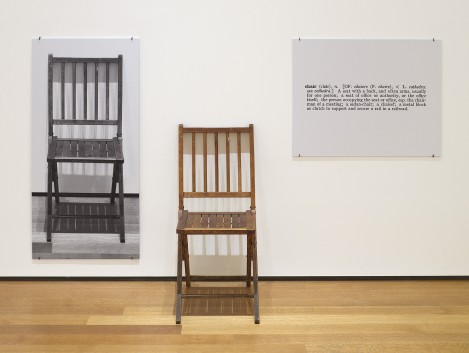In her article, “Language Between Performance and Photography,” Liz Kotz discusses the various ways in which language functions in contemporary conceptual art. Through an examination of Brecht’s Three Chair Events and Joseph Kosuth’s One and Three Chairs, she explores how each artist perceived language, photography, and the reduction of art. What becomes evident is that in Brecht’s attempt to create temporal art, he leaves his artwork vulnerable to reduction, while Kosuth manages to safeguard his art against reduction through incorporation.

(Goerge Brecht, Three Chair Events from Water Yam, 1963, http://www.fondazionebonotto.org/en/collection/fluxus/brechtgeorge/412.html)
To the Fluxus artists of the 1960s, photography was considered “representational and static,” and therefore in opposition with their temporal art (Kotz, 6). Thus it is not surprising that photography was excluded from Brecht’s Three Chair Events–a performative art event that presented three chairs in different contexts accompanied by an “event score.” While the Fluxus artists are not mistaken in considering photography “secondary,” inaccurate manifestations of ephemeral art, “event scores” are no more “primary.” Inevitably, post-event representations of Three Chair Events rely almost solely on the “event score,” reducing the ephemeral to the permanent. Once instructive, and art informative, the event score will act only as a document, a testament to the lost performance, and thus alter the very nature of the artwork. The participant becomes a viewer, temporal event becomes physical artifact. Therefore, if the event will ultimately face reduction due to the tangible, permanent existence of the event score–which currently resides in the Museum of Modern Art’s collection–photography should not be regarded as more contrived than the event scores.
Conversely, as One and Three Chairs confronts and incorporates reduction, the work’s intent is preserved. One and Three Chairs, part of Kosuth’s Proto-Investigations, displays three manifestations of a chair–a physical chair, a photograph of the same chair, and the textual display of the English definition of a chair. The artwork prompts the viewers to consider to what varying extents the three manifestations constitute a chair. Are the manifestations substitutable, or in-equivalent? Paradoxically, it appears as if the three manifestations comprise an entirety while simultaneously functioning differently systematically. Regardless of the conclusion that each viewer draws, the artwork evidently initiates the same cognitive conversation and thus continues to thrive. Thus as Kosuth’s work is about reduction, One and Three Chairs resists simplification, while Three Chair Events is ultimately reduced.

(Joseph Kosuth, One and Three Chairs, 1965, https://www.moma.org/learn/moma_learning/joseph-kosuth-one-and-three-chairs-1965)